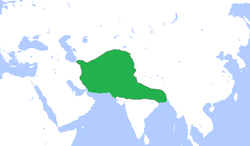Sayf al-Din Suri
Sayf al-Din Suri (Persian: سیف الدین سوری) was the king of the Ghurid dynasty from 1146 to 1149. He was the son and successor of Izz al-Din Husayn.
| Sayf al-Din Suri | |
|---|---|
| Malik of the Ghurid dynasty | |
| Reign | 1146-1149 |
| Predecessor | Izz al-Din Husayn |
| Successor | Baha al-Din Sam I |
| Born | Ghor |
| Died | 1149 Pul-i Yak Taq |
| House | Ghurid |
| Father | Izz al-Din Husayn |
| Religion | Sunni Islam |
Biography
When Sayf al-Din Suri ascended the throne, he divided the Ghurid kingdom among his brothers; Fakhr al-Din Masud received land near the Hari River; Baha al-Din Sam I received Ghur; Shihab al-Din Muhammad Kharnak received Madin; Shuja al-Din Ali received Jarmas; Ala al-Din Husayn received Wajiristan; and Qutb al-Din Muhammad received Warshad Warsh, where he built the famous city of Firuzkuh.[1] However, Sayf later quarreled with his brother Qutb, who took refuge in Ghazna, and was poisoned by the Ghaznavid sultan Bahram-Shah of Ghazna.
In order to avenge his brother, Sayf marched towards Ghazna in 1148, and scored a victory at the Battle of Ghazni while Bahram fled to Kurram.[2] Building an army, Bahram marched back to Ghazna. Sayf fled, but the Ghaznavid army caught up with him and a battle ensued at Sang-i Surakh. Sayf and Majd ad-Din Musawi were captured and later crucified at Pul-i Yak Taq. After his death, he was succeeded by his brother Baha al-Din Sam I.
References
- History of Civilizations of Central Asia, C.E. Bosworth, M.S. Asimov, pp. 185-186.
- C.E. Bosworth, The Later Ghaznavids, 113-114.
Sources
- C. Edmund, Bosworth (2001). "GHURIDS". Encyclopaedia Iranica, Online Edition. Retrieved 5 January 2014.
- Bosworth, C. E. (1968). "The Political and Dynastic History of the Iranian World (A.D. 1000–1217)". In Frye, R. N. (ed.). The Cambridge History of Iran, Volume 5: The Saljuq and Mongol periods. Cambridge: Cambridge University Press. pp. 1–202. ISBN 0-521-06936-X.CS1 maint: ref=harv (link)
| Preceded by Izz al-Din Husayn |
Malik of the Ghurid dynasty 1146–1149 |
Succeeded by Baha al-Din Sam I |
